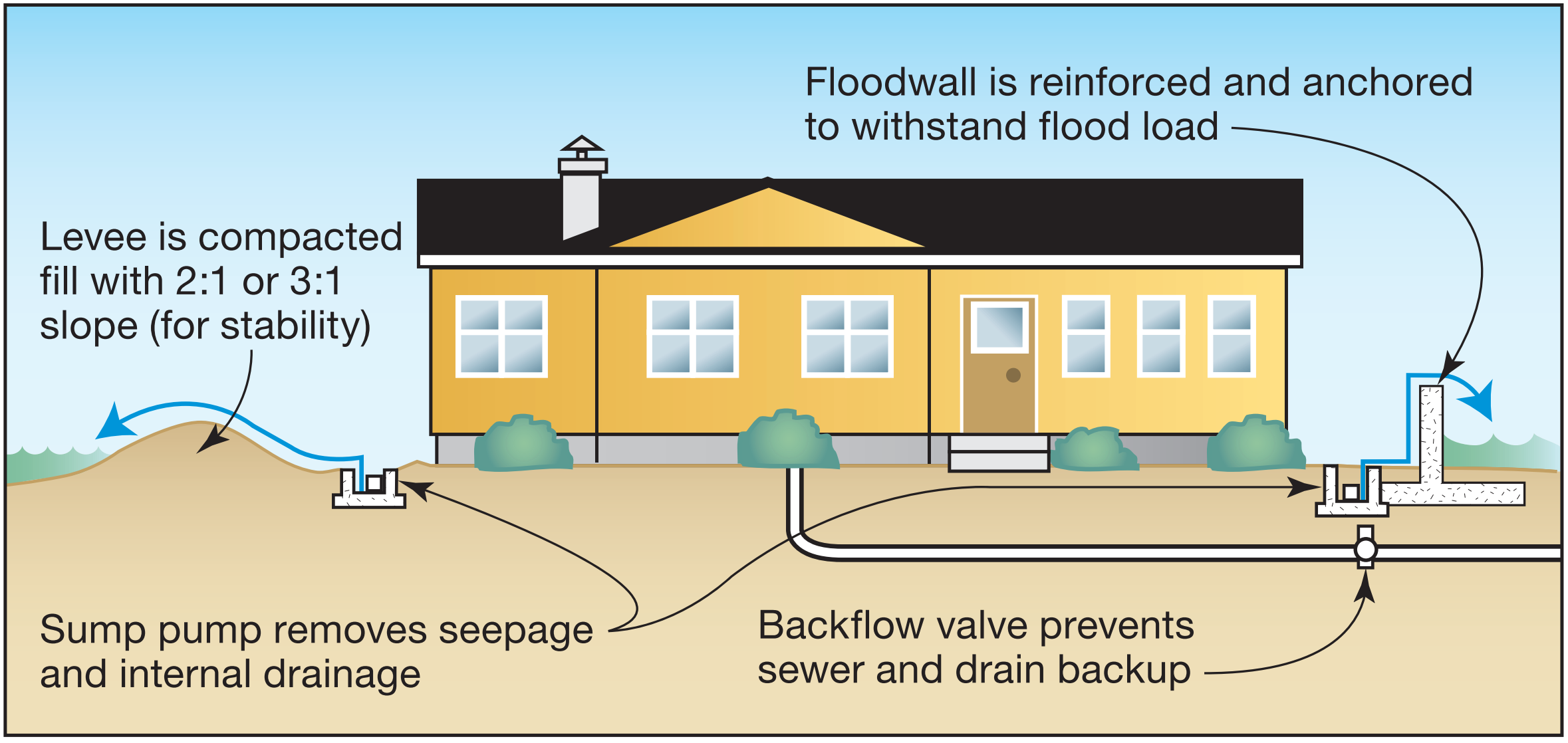Flood Barriers
Install Permanent Flood Barriers: Levees & Floodwalls
What Is It?

FEMA
Vulnerable building sites can be protected from floods through the use of levees and floodwalls. Levees and berms are structures made of compacted earthen materials with interior cores of impermeable soil (i.e. clay). Construction typically begins with excavation to ensure subsurface soil conditions are taken into account in design. Floodwalls are typically engineered structures made of reinforced concrete. Floodwalls can be built up to 20 feet in height and can be designed to be aesthetically pleasing architectural and landscape features. Floodwalls are typically more expensive to construct than levees, but require less space and landscaping and are more resistant to erosion. Construction of all floodwalls and levees should be undertaken by licensed engineers.
Due to the large amount of space needed for construction, the use of levees and floodwalls may be difficult and cost prohibitive in urban environments and may only be suitable for integration into new construction. In particular, levees and berms require a large quantity of earthen fill, and a lack of readily available, nearby fill may cause transportation costs to be prohibitive. Higher levees and floodwalls require significantly more support to withstand the greater water pressure exerted on the barrier. Strengthening levees and floodwalls requires increases in size, which may exceed the amount of space available on a building site and become impractical. Levees are typically limited to 6 feet in height and floodwalls to 4 feet to maintain cost-effectiveness. Sites with expected flood depths that exceed practical barrier heights should consider using alternate methods (e.g. elevation or floodproofing) instead of or in addition to permanent flood barriers. Barriers must be located a sufficient distance away from structures with basements to prevent damage to basement walls from the additional pressure from saturated soils. Regular maintenance is crucial to maintain service life.
With the reality of climate change threatening coastal security worldwide, it is essential to both proactively mitigate the effects, such as preparing against flooding from sea level rise, and combat the root causes by taking action to lower emissions, promote sustainability measures, and raise environmental awareness.
Benefits
- Floodwalls and levees will protect a building site from floodwater damage. As a result, protected structures will not need additional modifications for flood protection.
- Site aesthetics can be preserved or enhanced. Floodwalls can utilize decorated bricks or be built into garden areas.
Drawbacks
- Levees and floodwalls cannot be used alone to bring substantially damaged or substantially improved structures into compliance with floodplain management ordinances and laws.
- The amount of excavation and space required for levees may make them impractical for existing sites and most building sites in urban areas. Floodwalls may be applicable in these sites, but are more expensive to construct.
- The use of levees and in some cases floodwalls may affect drainage in the area, potentially worsening flood damage in adjacent sites.
Regulatory Impacts and Requirements
Potential regulatory touchpoints in Boston and Massachusetts include:
- Inspectional Service Department
- Building Code/Permit
- Public Improvement Commission
Financing Options, Incentives, and Rebates
- FEMA Hazard Mitigation Assistance: FEMA provides funding for flood and disaster mitigation through three grant programs: Hazard Mitigation Grant Program, Pre-Disaster Mitigation, and Flood Mitigation Assistance. Additional information and application instructions are available here through the Massachusetts Emergency Management Agency. Only non-residential dry floodproofing projects are eligible.
- Hazard Mitigation Funding Under Section 406 of the Stafford Act: Local, state, tribal, and some non-profit facilities damaged by disasters may use Section 406 funding to restore damaged facilities, as well as undertake preventative measures for future flood mitigation.
Resources:
News:
- “As Seas Rise, City Mulls a Massive Sea Barrier Across Boston Harbor,” Boston Globe, February 2017
- “When the Levee Doesn't Break” New York Times, May 2011
Project Examples:
- Haverhill Floodwall, MA: $5.4 million in repairs to a 30 feet floodwall along the Merrimack River.
- North Adams (MA) Local Protection Project: includes 4,000 feet of earthfill dikes and 3,840 feet of concrete floodwalls along the Hoosic River
- Lourdes Hospital, NY: 11 FloodBreak passive flood gates combined with 11-foot floodwall at a cost of approx. $7 million
- New Orleans, LA: After the infamous design failure of the levee and floodwall system in 2005 during Hurricane Katrina, a $14.5 billion civil works design


